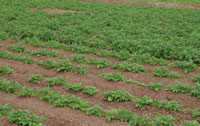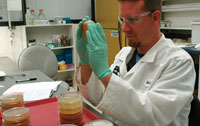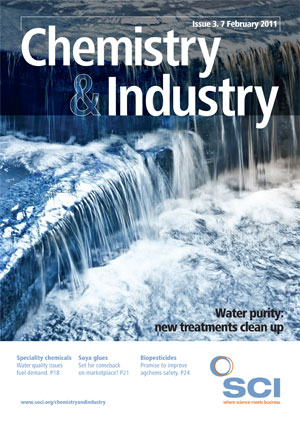Last year marked a great year in biopesticides. Interest in this technology in 2010 was highlighted by a number of deals between agchem multinationals and biopesticide companies. AgraQuest partnered with Monsanto, for example, to develop biopesticides for seed treatments and formed a marketing deal with BASF to deliver Serenade fungicides to worldwide markets. Bayer acquired the biopesticide technology and assets of Israel-based Agrogreen in March 2010 and Novozymes has expanded its focus in this space with the recent acquisition of Merck Crop Bioscience/EMD. Other major agchem firms like FMC, Arysta LifeScience, Syngenta and Makhtesim have dedicated teams focused on developing new crop protection products internally or through partnerships with smaller biopesticide firms.


Today, it is used in 26 countries around the world for broad spectrum control of fungi and bacterial diseases, predominantly in high-value fruit and vegetables. Thanks to sales of Serenade, and other newer products, at the end of 2010, AgraQuest looked on track to achieve over 40% growth on the previous year’s sales.
One of the main drivers behind the growth of biopesticides is the need to grow foods more sustainably, minimising the environmental and human effects from agricultural activities. Current estimates indicate that world population will exceed 9bn by 2050, requiring 70-100% more food from the same land area. Simultaneously, environmental and human safety concerns are driving governments to enact stricter protections of resources, farm workers, neighbours and the environment.
These protections include the elimination of some older, toxic pesticides from growers’ toolkits. In the EU, for example, 600 of 1000 registered pesticide active ingredients have been de-listed in recent years and are no longer available for sale and 300 more are still under review. Other countries around the world are conducting similar reviews. The EU’s Sustainable Use Directive mandates new approaches for agriculture by 2014, with national timelines, targets and measures to reduce the risk and impacts of pesticide use on human health and reduce dependency on pesticides. While the Directive includes numerous provisions in support of ‘non-chemical methods or alternatives’ and ‘biological pest control’, it is unclear whether these explicitly address biopesticides. France’s National Action Plan, for example, issued in 2008, calls for a reduction of pesticide use by 50% in ten years, if possible.
Additionally, consumers in affluent nations have been driving substantial change in food production through their willingness to pay for organic or pesticide-free products. In many cases, European food retailers are imposing even stricter pesticide limits on their suppliers of fresh produce than mandated by regulators, as a point of competitive differentiation in the marketplace. In this context, biopesticides give growers tools to replace existing pesticides without detrimental environmental or human health effects – while maintaining similar levels of pest control and similar or improved yield benefits.
Biopesticides can fill many of these gaps in growers’ chemical control programmes left by loss of older, more toxic agrochemicals. In Ecuador, for example, Serenade has replaced mancozeb used as a contact fungicide for control of black sigatoka in bananas, when plantations there determined they would no longer rely on mancozeb. Bio-insecticides can similarly replace banned synthetic insecticides. AgraQuest’s Requiem, for example, can completely replace endosulfan – already banned in the EU and leaving the market soon in the US – in growers’ pest control programmes for vegetable production.
Importantly as well, growers can use biopesticides to reduce the quantities or rates of pesticides that are not banned – copper fungicides and bactericides, for example. In Florida, US, growers use a reduced rate of copper along with Serenade fungicide for improved control of bacterial spot in tomatoes while lowering the metal load on the environment. This strategy can also reduce the levels of synthetic pesticide residues on fresh market produce.
Improvements in biopesticide formulation are a newer trend, allowing growers to interact with biopesticides in much the same ways they interact with conventional pesticides. Many biopesticides are stored alongside conventional pesticides, can be handled similarly, are applied through the same equipment and are often used within the same treatment programme.
Another trend has been the expanded uptake of biopesticide by conventional growers. Where biopesticides have in the past been relegated to the organic field, today growers of conventional crops are using biopesticides within their production programmes. At AgraQuest, 97% of product sales are for the ‘conventional acre’.
Biopesticides are also becoming increasingly useful, meanwhile, outside agriculture. In 2009, AgraQuest created a new division called BioInnovations to expand the adoption of biopesticides into adjacent but related segments. Today, biopesticide products are sold as animal nutrition products, for bioremediation, in professional turf care, in ornamental production, to consumers for home and garden, as seed treatments and for post-harvest decay control.
AgraQuest has been growing at 30-50%/year for the past several years. We expect to be a $200m company in 2015 through the growth of current products and active ingredients and through aggressive development of new proprietary microbial active ingredients. The company’s recent Monsanto R&D collaboration is important as it integrates biopesticides into broad acre crops, where they have historically struggled to find a market fit. In fruits and vegetables, growers choose biopesticides to manage their MRL (maximum residue levels) or to protect beneficial insects. But broad acre crops, in general, don’t have those same drivers, though there have been breakthroughs, such as the introduction of Serenade for control of Sclerotinia fungus in Canadian canola and BalladPlus in US soya beans. The Monsanto collaboration will deliver biopesticide technologies to some of the largest- acre crops, effectively placing products throughout the production spectrum – from organic production all the way through to broad-acre crops.
Finally, this is part of a stream of deals with major agrochemical players, including with BASF and Bayer CropScience. The BASF deal is a global distribution partnership, whereby BASF distributes Serenade fungicide in the markets outside North America. For Bayer CropScience, AgraQuest provides active ingredients to its home and garden products. The collaboration with Monsanto defines another deal structure and demonstrates the many different ways the global agchem majors can work with biopesticide technologists.
Looking to the future, demand for biopesticides is expected to grow. Only 21% of organics consumers cut down on or eliminated organics during the recession, despite their higher price, according to a recent report on green living by market research firm Mintel. Other consumers have increased their demand for no or lowpesticide products. Additionally, governments worldwide are increasing their scrutiny of existing agchems and will be disallowing the use of some of the oldest and most toxic pesticides. These market forces are expected to strengthen and, when coupled with the need for more production per acre to feed the world’s growing population, the future for effective biopesticides that provide valuable tools for growers to meet these demands, looks very bright.
Biopesticides – a working definition
The US Environmental Protection Agency defines biopesticides as derived from natural materials like plants, bacteria, minerals and animals. They are usually:
- less toxic than conventional pesticides;
- affect only the target pest; and
- decompose quickly, resulting in lower exposures and avoiding pollution
When used in Integrated Pest Management (IPM) programmes, they can greatly decrease the use of conventional pesticides while crop yields remain high. Because biopesticides often have unique – and sometimes multiple – modes of action, they can help prevent the development of resistance to conventional pesticides. Biopesticides are also generally less destructive to beneficial insect and pollinator populations.
Some products on the marketplace
In the US in 2010, AgraQuest introduced Serenade Soil, a fungicide for use against soil diseases like Fusarium, Rhizoctonia, Pythium, and Phythophthora. The metabolites in Serenade soil attack soil diseases on contact. Additionally, the beneficial bacteria in the product migrate to the root zone and live there in the rhizosphere, protecting the young root – like a suit of armour – from incoming diseases. While the beneficial bacteria are living in the root zone, they produce plant growth-promoting compounds, like auxins and 2,3-butanediol, that result in healthier, higher yielding plants. Three years of study show that fields of potatoes, tomatoes and cucurbits treated with Serenade soil yielded ~14% higher than those not treated, much higher than yield improvements from conventional fungicides.
Sonata and Ballad Plus fungicides are based on the active ingredient Bacillus pumilis QST 2808. They provide control of rusts and mildews by a unique mode of action targeting the fungal cell wall. Sonata is focused on fruit and vegetables, while Ballad Plus is available for broad acre crops. In four years of studies in the US, the latter was shown to increase yields of soya.
Requiem targets sucking pests like thrips, aphids, mites and whiteflies in fruits, vegetables, trees and vines. It has a triple mode of action that desiccates the outer layer of the insects, attacks their respiratory systems and interferes with their ability to feed. Requiem suppresses virus in treated fields, largely due to the cessation of insect feeding, and is a tool for growers looking to alternate chemical modes of action to prevent the development of resistance.
All the above products are exempt from residue tolerance, meaning that growers can safely export crops grown using these products without worrying their pesticide residues will exceed import limits. They also preserve populations of beneficial insects and pollinators.
Sarah Reiter is director of global marketing at AgraQuest, based in Davis, California, US.





